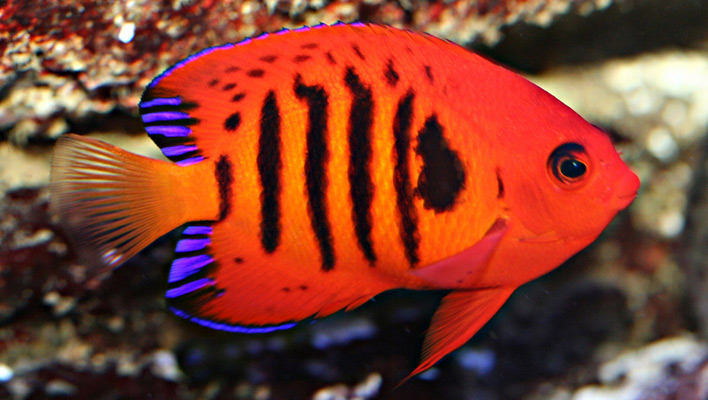The aptly named flame angelfish (Centropyge loriculus) is an eye-popping Pacific beauty that stops people in their tracks when they catch sight of it in a home aquarium or LFS sales tank. This stunning dwarf angel has much to recommend it when it comes to aquarium keeping, provided a few special considerations are taken into account before introducing one.
Physical attributes
As the first half of its common name suggests, C. loriculus is a fiery orange-red overall with a series of black vertical bars along its flanks. The posterior edges of its dorsal and anal fins are trimmed in blue. It’s a wonder that something so conspicuously colored to human eyes becomes virtually invisible at depth in the ocean! In common with all angelfishes, the flame angel possesses a sharp, backward-facing spine on the lower edge of each gill cover, which can present an entanglement risk if you try to net this species. The flame angel’s maximum size is approximately 4 inches.
Proper housing
Despite its relatively small size, C. loriculus is not a good candidate for smaller or nano aquariums. This is a high-energy species that needs ample swimming room. Also, you must be sure to provide a good amount of high-quality live rock for the specimen to continually graze/nibble upon as well as take refuge in whenever it feels threatened. We would recommend an established, mature system that is no smaller than 40 gallons as minimum housing.
Tankmates
Here’s where C. loriculus’ slightly devilish nature comes into play. Again notwithstanding its diminutive size, the flame angel can be surprisingly aggressive toward fishy tankmates—especially members of its own species, congeners, and any other species that are similar in size, shape, color, or the niche they tend to occupy on the reef. I once had a specimen that bullied a significantly larger schooling bannerfish so severely that I had to remove the bannerfish. It even bit a chunk out of the poor thing’s banner! So, any tankmates must be sufficiently large, different in appearance, and assertive to keep the flame angel in its place. Also, be sure to introduce the flame angel after any more-peaceful species that might be on your stocking list.
C. loriculus can be kept in reef systems, though its constant nibbling behavior may extend to fleshy and large-polyped invertebrates, which can cause them to remain contracted to the detriment of their health. So we would consider this species tentatively reef-safe depending on the invertebrates kept.
Feeding
The flame angelfish is omnivorous and will usually learn to accept a wide range of standard aquarium fare with few problems. Offer several feedings throughout the day, alternating various meaty and algae-based items of an appropriate size, rather than one large feeding. Examples of good food options include a high-quality staple pellet food, frozen mysid shrimp, frozen plankton, chopped clams, spirulina flakes, and frozen herbivore formulations.



